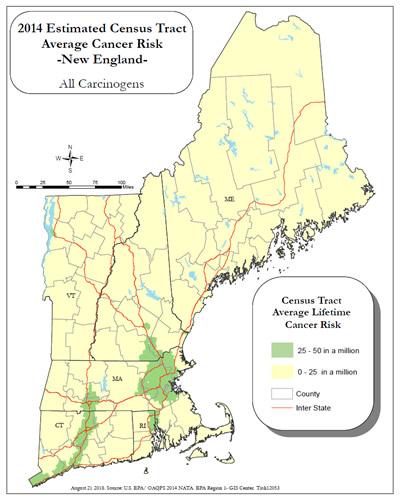New England Results of the 2014 National Air Toxics Assessment
- New England Short Summary of 2014 National Air Toxics Assessment
- What is Being Done to Reduce Air Toxics?
- What Do We Know About Air Toxics Trends in New England in the Ambient Air?
Background
In August 2018, EPA released the results of the 2014 National Scale Air Toxics Assessment (NATA). EPA utilized its air emission inventory complemented with state data to model ambient concentration estimates for 180 hazardous air pollutants, plus diesel particulate matter. In this assessment, EPA estimated people's exposure to air toxics to characterize public health risks. NATA is a screening tool, intended to help EPA, and state, local and tribal air agencies determine if areas, pollutants or types of pollution sources need to be examined further to better understand risks to public health.
Coordination with States and Tribes
EPA Region 1 coordinated with the states, tribal governments and the Northeast States for Coordinated Air Use Management (NESCAUM) Air Toxics and Public Health Committee to review the results of NATA and quality assure the data prior to releasing the data to the public. The results of the NATA are dependent on this close, cooperative interaction to develop and refine the 2014 air toxics inventory.
Key Findings in New England
Air Toxics of Greatest Concern in New England
- State average risk values of four air toxics: acetaldehyde, benzene, carbon tetrachloride, and formaldehyde exceeded health benchmarks in every state in New England, and state average risk values of 1,3-butadiene exceeded health benchmarks in two states in New England. A cancer risk health benchmark of 1 in 1 million was used for this evaluation. A risk level of 1 in 1 million refers to the likelihood that 1 in 1 million people would develop cancer if they breathe air containing the same amount of the same air toxic for a 70-year lifetime.
- Although there is no established cancer health benchmark for diesel particulate, people are exposed to high concentrations of diesel particulate so it is also an air toxic of concern.
- Mobile sources and residential wood combustion represent significant emission categories for 1,3-butadiene and benzene.
- Background sources, including natural sources, emissions from prior years that persist in the environment, and distant sources, account for the majority of ambient air concentrations for carbon tetrachloride, a persistent, globally ubiquitous pollutant.
- Secondary formation accounts for the majority of the risk estimates for acetaldehyde and formaldehyde, although mobile sources and residential wood combustion represent significant emissions categories of anthropogenic emissions of these pollutants. Secondary formation refers to pollutants that form in the air through chemical reactions; secondary air toxics often form via reactions between human-emitted and naturally occurring compounds.
There are other air toxics including arsenic, ethylene oxide, hexavalent chromium, naphthalene, and trichloroethylene for which census tract risk values in New England exceeded a cancer risk level of 1 in 1 million. These may be a potential concern at the local level rather than the regional level. There are also other air toxic pollutants, including asbestos, dioxin, lead, mercury, PCBs and radon, that are also a concern due to other routes of exposure or exposure from indoor sources and these continue to be a focus of our actions.
The following Table includes information on the emissions sources, and health effects for the air toxics of greatest concern in New England.
You may need a PDF reader to view some of the files on this page. See EPA's PDF page to learn more about PDF, and for a link to the free Acrobat Reader.
| Pollutant | Health Effects | Sources in New England |
|---|---|---|
| Acetaldehyde | Health Effects (PDF) (4 pp, 62 K) | Summary (PDF) (1 pg, 68 K) |
| Benzene | Health Effects (PDF) (5 pp, 61 K) | Summary (PDF) (1 pg, 78 K) |
| 1,3-Butadiene | Health Effects (PDF) (4 pp, 62 K) | Summary (PDF) (1 pg, 69 K) |
| Carbon Tetrachloride | Health Effects (PDF) (5 pp, 83 K) | |
| Diesel particulate matter | Health Effects | Summary (PDF) (1 pg, 71 K) |
| Formaldehyde | Health Effects (PDF) (5 pp, 95 K) | Summary (PDF) (1 pg, 74 K) |
Summation of Carcinogenic Risk Estimate Map of New England
The following map represents a summation of carcinogenic risk estimates in New England for inhalation exposure to air toxics modeled in the 2014 National Air Toxic Assessment. The risk estimates in the map are based on the census tract level average of a typical individual's exposure.
The following limitations to these carcinogenic risk estimates for exposure to these air toxics must be noted: the inhalation route of exposure is the only exposure route that has been evaluated, only inventoried outdoor air toxic sources were used in this assessment since there isn't adequate data on indoor air exposures, and the risks associated with each carcinogenic pollutant are only added together since there is inadequate information on other health effect interactions.
These carcinogenic risk estimates can not be related to an individual's risk of cancer because the estimates are restricted to 2014 estimates and the results should be reviewed across broad geographic areas such as counties and states. These risk estimate maps should not be used to obtain information on specific types of cancers or possible cancer clusters but they can provide EPA, the states and the public with information on whether we're focusing on the right pollutants and sources to protect the public health.
 2014 Estimated Census Tract Average Cancer Risk in New England
2014 Estimated Census Tract Average Cancer Risk in New England
Source: U.S. EPA / OAQPS 2014 Nata (XLSX) (1 pg, 61 MB)
For more information about air toxics in New England, please contact:
Susan Lancey (lancey.susan@epa.gov)
For general information about other EPA programs, contact:
The EPA New England call center at (617) 918-1111
